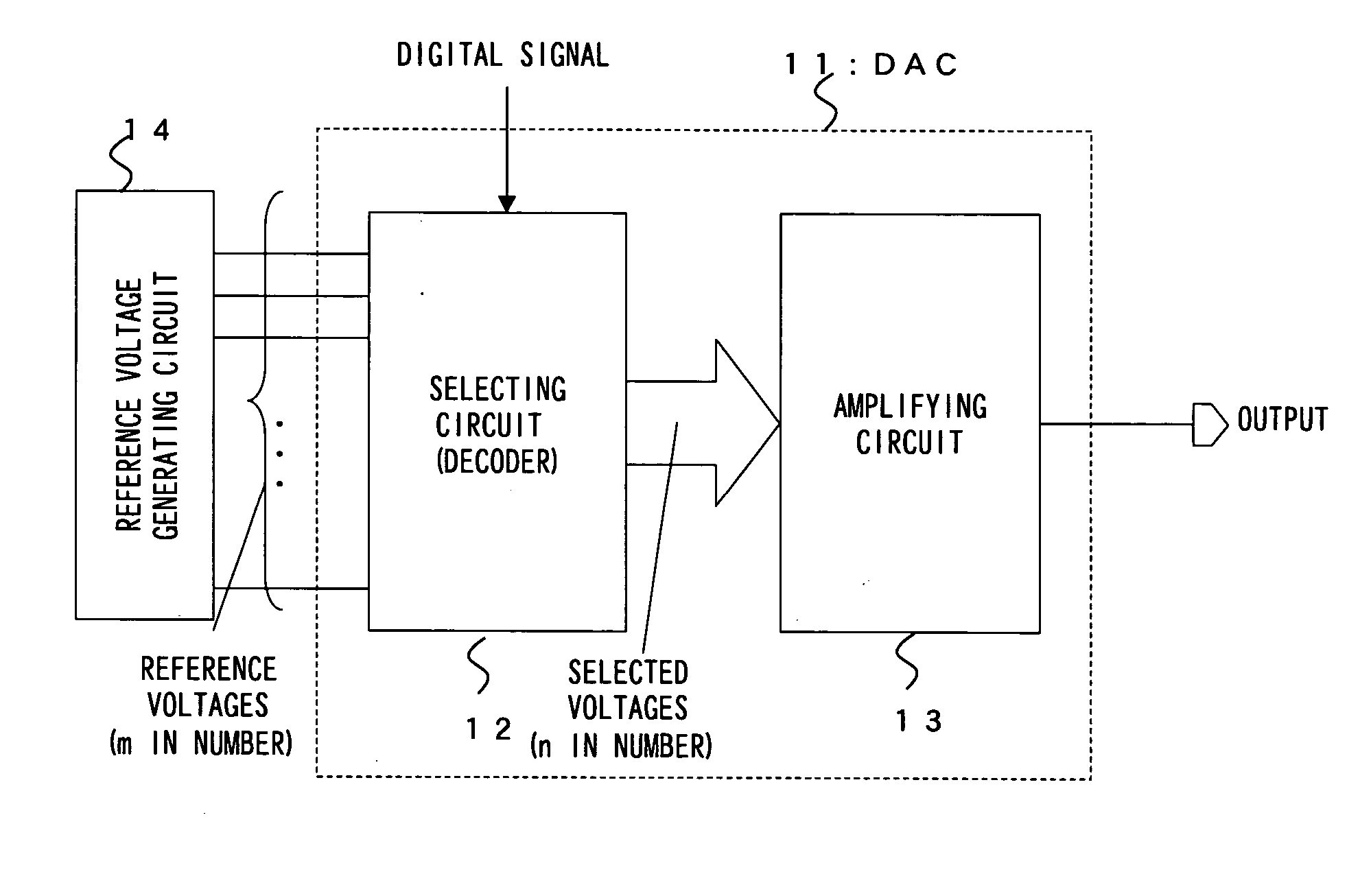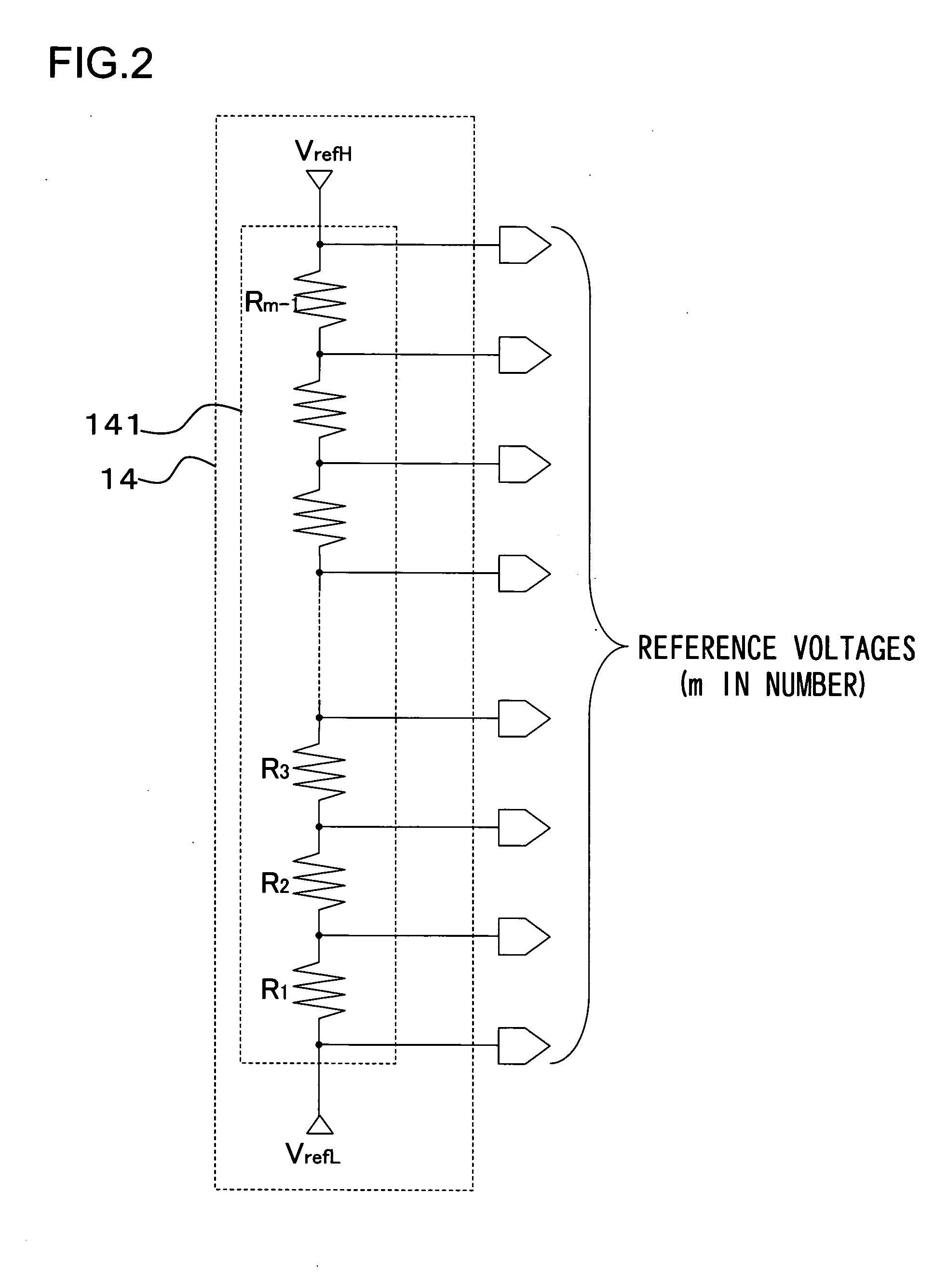Digital-to-analog converter, data driver and display device using same
a digital-to-analog converter and data driver technology, applied in the direction of digital-analog converters, transmission systems, instruments, etc., can solve the problems of increasing the chip area of the data driver lsi chip, increasing the number of bits of video data, increasing the cost, etc., and achieving the effect of reducing the area and reducing the cos
- Summary
- Abstract
- Description
- Claims
- Application Information
AI Technical Summary
Benefits of technology
Problems solved by technology
Method used
Image
Examples
second embodiment
[0122] Next, a case where the decoder 12 of FIG. 1 has n output terminals (i.e., where the amplifying circuit 13 has n input terminals) will be described as the present invention. That is, the decoder 12 receives m reference voltages that differ from one another, selects n voltages, inclusive of voltages that may be identical, from among the m reference voltages based upon a selecting signal, and supplies the selected voltages to n output terminals T1, T2, . . . , Tn.
[0123] Further, the amplifying circuit 13 outputs a voltage obtained by taking the weighted mean of the n voltages, which have been supplied to the terminals T1 to Tn, at a ratio of 2n−1:2n−2: . . . :20. Let VQ1, VQ2, . . . , and VQn represent the n voltages supplied to the terminals T1 to Tn.
[0124] A case where there are four reference voltages and three output terminals T1, T2 and T3 of the decoder 12, namely a case where m=4, n=3 holds, will now be described as an example. FIG. 31 is a diagram illustrating the relat...
third embodiment
[0186] Next, a case where the decoder 12 in FIG. 1 has a single output terminal (the amplifying circuit 13 has a single input terminal) will be described as the present invention. That is, the decoder 12 receives as inputs the m reference voltages that differ from one another, selects n voltages, inclusive of voltages that may be identical, from among the m reference voltages based upon a selecting signal, and successively outputs the selected voltages to a single output terminal. Further, the amplifying circuit 13 successively receives as inputs the n voltages selected at the single output terminal and outputs voltages obtained by taking the weighted mean of the entered n voltages at the ratio 2n−1:2n−2: . . . :20. The single output terminal will be expressed by T0 below, and the n voltages successively supplied to the terminal T0 will be denoted by VQ1, VQ2, . . . , and VQn.
[0187]FIG. 19A is a diagram illustrating an example of the configuration of the amplifying circuit 13 accord...
fourth embodiment
[0238] Next, a case where the decoder 12 of FIG. 1 has r (213 has r input terminals) will be described as the present invention. That is, the decoder 12 receives as inputs the m reference voltages that differ from one another, selects n voltages, inclusive of voltages that may be identical, from among the m reference voltages based upon a selecting signal, and successively outputs the selected voltages to r output terminals.
[0239] Further, the amplifying circuit 13 successively receives as inputs the n voltages selected at the r output terminals and outputs voltages obtained by taking the weighted mean of the entered n voltages at the ratio 2−1:2n−2: . . . :20. The r output terminals will be expressed by T0 to Tr below, and the n voltages successively supplied to the terminals T0 to Tr will be denoted by VQ1, VQ2, . . . , and VQn, respectively.
[0240]FIG. 24A is a diagram illustrating an example of the configuration of the amplifying circuit 13 according to this embodiment, and FIG....
PUM
 Login to View More
Login to View More Abstract
Description
Claims
Application Information
 Login to View More
Login to View More - R&D
- Intellectual Property
- Life Sciences
- Materials
- Tech Scout
- Unparalleled Data Quality
- Higher Quality Content
- 60% Fewer Hallucinations
Browse by: Latest US Patents, China's latest patents, Technical Efficacy Thesaurus, Application Domain, Technology Topic, Popular Technical Reports.
© 2025 PatSnap. All rights reserved.Legal|Privacy policy|Modern Slavery Act Transparency Statement|Sitemap|About US| Contact US: help@patsnap.com



